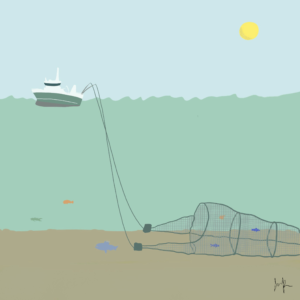Illustrated by Julianne Park. All rights reserved.
An aquifer is a layer of porous water-saturated rock underground. Groundwater can be extracted from this water resource to provide drinking water, irrigation, and other purposes.
Aquifers are, by definition, renewable resources. However, it is subject to depletion when the withdrawal rate surpasses the rate of recharge. And since aquifers take thousands of years to refill, an unsustainably managed aquifer is, thus, nonrenewable.
With half the world’s population depending on aquifers as a source of their water, managing this crucial source is essential.
The Ogallala Aquifer is located beneath the Great Plains and supplies irrigation water for nearly a third of the Midwestern states. However, the groundwater pumping rate is estimated to be around 22-25 mm per year, according to Mission 2012 Clean Water, a speed up to forty times faster than the aquifer’s natural recharge rate.
Aquifer depletion has countless consequences.
First, with not enough water to grow crops, there will be food shortages and increased water competition among agricultural industries, namely farmers and ranchers.
Second, there will be a loss of biodiversity. Ogallala’s groundwater feeds into springs that support wetlands, habitats for many species.
Third, it may cause land subsidence. Groundwater withdrawal changes the water pressure, causing the rock underneath to collapse; the land above the aquifer will sink or subside. Sudden land subsidence is more commonly known as a sinkhole.
Fourth, lowering the water tables and groundwater overdrafts can lead to saltwater intrusion. Saltwater is unsuitable for irrigation and is also undrinkable.
Fifth, it will take up to 6,000 years to recharge, a rate too slow to accommodate our massive water needs and rate of withdrawal (Scientific American).
This issue is by no means confined to the Ogallala Aquifer alone. And this is a global problem and a social issue. The overpumping of groundwater intertwines with other social conflicts, such as poverty, food scarcity, rising food prices, and widening wealth gaps. Countries in the Middle East, in addition to their growing populations, are struggling with a crisis of dropping water tables from the over-pumping of aquifers (PRB).
However, there are solutions to prevent this issue.
To prevent this crisis from occurring in the first place, we need to use our water more efficiently. That means reducing our water usage by changing to more sustainable irrigation. Instead of spray or flood irrigation, we could switch to drip irrigation. Instead of growing water-intensive crops, harvest drought-resistant crops with low water needs in dry areas. The number of wells created can also be limited to prevent further groundwater depletion. In addition, the Government can also subsidize water conservation by providing benefits and incentives for farmers to use water more sustainably. They can stop providing subsidies that encourage the production of water-thirty crops in arid areas completely.
Works Cited
“Finding the Balance: Population and Water Scarcity in the Middle East and North Africa.” PRB, www.prb.org/resources/finding-the-balance-population-and-water-scarcity-in-the-middle-east-and-north-africa/.
Little, Jane Braxton. “Saving the Ogallala Aquifer.” Scientific American, vol. 19, no. 1, 1 Mar. 2009, pp. 32–39, www.scientificamerican.com/article/the-ogallala-aquifer/, https://doi.org/10.1038/scientificamericanearth0309-32.
“Mission 2012 : Clean Water.” Web.mit.edu, web.mit.edu/12.000/www/m2012/finalwebsite/problem/groundwater.shtml#:~:text=Specifically%2C%20the%20Ogallala%20Aquifer%20is.
The views and opinions expressed are those of the authors and do not necessarily reflect nor represent the Earth Chronicles and its editorial board.










